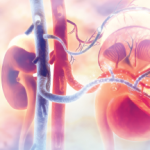Calciphylaxis, or calcific uremic arteriolopathy, is a rare disease characterized by calcification of the arterioles and capillaries in the dermis and subcutaneous tissue, resulting in thrombus formation and subsequent skin ischemia and necrosis.1 This serious condition most commonly occurs in patients with end-stage renal disease (ESRD) requiring dialysis or in kidney transplant recipients. In rare cases, warfarin has been associated with non-ESRD-related calciphylaxis.1
Diagnosis of this disease can be challenging because it can mimic a vasculitis.2 We describe a patient without ESRD but on warfarin who presented with necrotizing skin lesions of unknown etiology and was eventually diagnosed with calciphylaxis. This case proved challenging due to the atypical etiology of this rare disease, its presentation clinically as a vasculitis and the requirement of multiple biopsies for a definitive diagnosis.
Introduction
Calciphylaxis is classically a disease associated with renal failure, with the majority of patients nearing or on dialysis.2 This condition can also occur without kidney disease, termed non-uremic calciphylaxis, and is most commonly associated with derangements in calcium and phosphate homeostasis, such as hyperphosphatemia, hypercalcemia and thyroid disease.2 Additionally, cases of exposure to warfarin as a cause for calciphylaxis have been documented.1 Non-uremic calciphylaxis is thought to be a small subset of overall calciphylaxis cases. As of 2016, 116 cases had been identified.3 Warfarin-induced non-uremic calciphylaxis represents an even smaller subset of these cases.
The suspected mechanism by which warfarin induces calciphylaxis is through the inhibition of vitamin K-dependent carboxylation of matrix Gla-protein, a mineral-binding extracellular matrix protein that prevents calcium deposition in arteries.4 This leads to progressive narrowing of cutaneous blood vessel lumens through calcification within the media layer of vessel walls and by the proliferation of endothelial cells and fibrosis underneath the intima.2 Thrombosis is the final step in calciphylaxis, which ultimately leads to complete vessel occlusion. Warfarin decreases protein C levels faster than the coagulation factors, therefore increasing thrombus formation.5 Ultimately, with microvascular thrombosis, ischemia develops.
Calciphylaxis often presents as cutaneous lesions of livedo reticularis, plaques, nodules and ulcers due to ischemia of the microvasculature.2 Plaques or nodules are the most common presenting lesions, which may be confused with cellulitis because both lesions can present with erythema, pallor and tenderness.2 Patients may have advanced disease, however, once the diagnosis is officially made.
Case Report
A 77-year-old woman with a past medical history of atrial fibrillation on 5 mg of warfarin daily for over a year and non-biopsy-proven giant cell arteritis on 25 mg of prednisone once a day presented to the dermatology and rheumatology clinics with a four-month history of a worsening reticulated violaceous rash on both her legs (see Figure 1). The rash initially started as a “black scab” on her left mid-shin. However, over the course of a month or so, she developed progressive, escalating pain as the areas of involvement increased in size and severity and, eventually, involved both shins.


